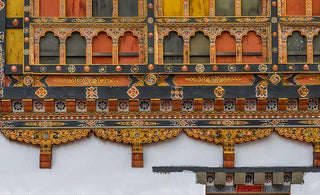
Tibetan Buddhist art is a profound reflection of spirituality, culture, and heritage. Its intricate symbols and hidden meanings encapsulate a rich tapestry of beliefs and traditions. At Oriental Aesthetics, we delve deep into the world of Tibetan Buddhist art, unlocking the enigmatic symbols and deciphering the veiled meanings that adorn these timeless masterpieces.
Understanding the Iconography of Tibetan Buddhist art
Tibetan Buddhist art is replete with symbolic imagery that communicates profound spiritual messages. Each color, deity, mudra, and motif holds deeper significance, representing aspects of the enlightened path. For instance, the green Tara symbolizes compassion, while the eight auspicious symbols embody the teachings of Buddha.
Thangkas, traditional Tibetan Buddhist paintings, serve as visual representations of spiritual concepts. These intricate artworks portray Buddhas, Bodhisattvas, mandalas, and mythical landscapes, inviting contemplation and meditation.
Crafted meticulously by skilled artisans, Thangka paintings are known for their intricate details and vibrant colors. The process of creating a Thangka is a meditative journey in itself, requiring precision and spiritual dedication. Artisans use natural pigments and precious metals, infusing the paintings with symbolic depth.
Spiritual and Meditative Tools: Thangka aren't merely decorative; they serve as spiritual guides and aids to meditation. When used in contemplation, they offer practitioners a visual focal point for concentration and spiritual reflection. The intricate symbolism embedded within each painting facilitates deeper understanding and connection to Buddhist teachings.
Depiction of Deities and Symbolism: At the heart of Thangka paintings lie depictions of Buddhas, Bodhisattvas, and celestial beings. Every aspect, from the gestures (mudras) to the colors, carries symbolic meaning. For instance, the White Tara embodies compassion, while the Vajra symbolizes unshakable determination.
Mandalas: Sacred Geometric Designs. Mandalas, often featured in Thangka paintings, are intricate geometric patterns symbolizing the universe. These cosmic maps represent the cosmos in microcosm, guiding practitioners through spiritual journeys and inner transformation. Mandalas serve as visual tools for meditation, enabling individuals to explore the deepest layers of consciousness.
Legacy and Cultural Significance: Thangka paintings carry a legacy that spans centuries, serving as vessels of Tibetan culture and spirituality. Beyond their aesthetic appeal, they are living repositories of ancient wisdom and teachings. Through preservation and appreciation, these artworks continue to inspire and educate generations about the profound philosophies ingrained in Tibetan Buddhism.
The Influence on Contemporary Art: The influence of Thangka paintings extends beyond their traditional context. Contemporary artists draw inspiration from the symbolic richness and spiritual depth of Thangkas, incorporating elements into modern art forms. This fusion of tradition and innovation ensures the perpetuation of Thangka's legacy in evolving artistic expressions.
The Wheel of Life (Bhavacakra)
The Wheel of Life, known as Bhavacakra in Sanskrit, is a profound symbol in Tibetan Buddhist art. This intricate depiction, often found in monasteries and temples, serves as a visual representation of life's perpetual cycle and the quest for spiritual liberation.
The Wheel of Life illustrates the perpetual cycle of samsara, the continuous cycle of birth, death, and rebirth. Divided into sections, it portrays the realms of existence, each representing different states of being and consciousness. From the heavenly realms to the realms of suffering, the wheel symbolizes the transient nature of life and the karmic consequences of actions.
Depiction of Inner Workings: The outer rim of the wheel symbolizes the twelve links of dependent origination, illustrating how ignorance leads to suffering and perpetuates the cycle of existence. The hub of the wheel contains symbolic representations of the three poisons—ignorance, attachment, and aversion—that bind individuals to the cycle of samsara.
Interpreting the Wheel of Life goes beyond its visual elements; it serves as a teaching tool, imparting profound spiritual wisdom. Understanding the symbolism within the wheel allows practitioners to contemplate the nature of existence and the causes of suffering. Through this contemplation, individuals gain insight into the path to liberation and the cessation of suffering.
Contemplating the Wheel of Life is a practice embraced by many Tibetan Buddhists. By reflecting on its intricate symbolism, practitioners gain a deeper understanding of the fundamental principles of Buddhism, encouraging them to walk the path towards spiritual awakening.
Preservation of Heritage
Tibetan Buddhist art serves as a vital repository of Tibetan culture and history. Through the preservation of these artistic expressions, Oriental Aesthetics contributes to safeguarding centuries-old traditions.
The profound nature of Tibetan Buddhist art transcends aesthetics; it serves as a catalyst for spiritual growth and enlightenment. By exploring and understanding these artworks, individuals embark on a journey towards inner awakening.
Oriental Aesthetics is committed to fostering a deep appreciation for classical oriental art. Through our systematic, high-quality professional services, we cater to the needs of oriental artists, collectors, and enthusiasts. Our dedication lies in preserving and promoting the rich cultural heritage, enabling individuals to immerse themselves in the spiritual and artistic magnificence of this ancient tradition.























